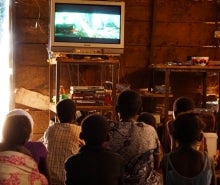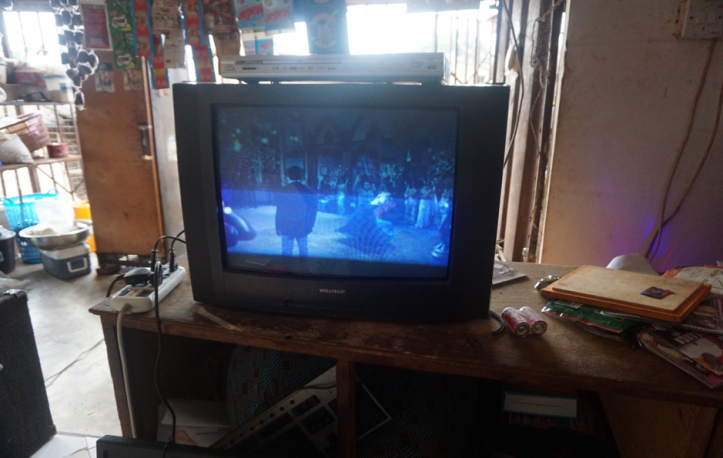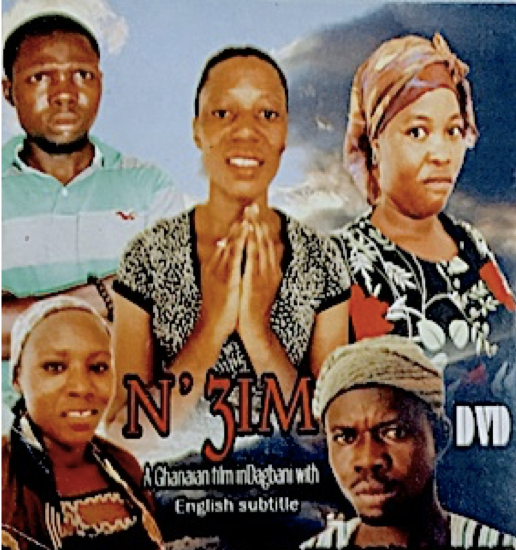“She’s Like Our Own Lata Mangeshkar”: The Playback Singers of Tamale, Northern Ghana

Introduction
In the city of Tamale, northern Ghana, Dagbani language popular music can be heard in taxis, on people’s mobile phones, and in the central market. Unlike more traditional popular music industries, where recording artists gain direct notoriety for their work, many Dagbani popular musicians have historically worked behind the scenes, composing and recording songs for the local Dagbani film industry.[i] Beginning in the early 1990s, Dagbani popular singers were commissioned by filmmakers to write and record songs for local films. After the songs were composed and recorded, they were passed on to actors, who lip-synced these songs in the films. In this post, I provide a brief history of the Dagbani film music industry in Tamale. Throughout, I consider the role that playback singers play in shaping both popular music and film culture in the region, and further explore their process for composing and performing diegetic film songs.
Many scholars have detailed the interconnectivity of dance, music, and theatre in West Africa. Scholarly work in this realm includes Hélène Neveu Kringelbach’s work on dance and theatre in Senegal (2013), as well as Karin Barber (2003), Catherine Cole (2001), and John Collins’ (1994; 1997) respective works on the relationship between music, dance, and theatre in Nigeria and Ghana. In what follows, I similarly engage with the interconnectivity of music and film in northern Ghana, where the disciplinary boundaries between media/film studies and music are porous.
Diegetic Film Songs in Northern Ghana
Diegetic song segments have been a part of the Dagbani film industry since it began in the early 1990s. Similar to the playback singers of the Hindi film industry, a handful of trained vocalists recorded the majority of songs for Dagbani films. By the late 1990s, nearly all recorded music albums circulating in Tamale were compilations of songs from Dagbani films (Yamusah 2013:79). Why did filmmakers in Tamale gravitate towards the use of diegetic songs in their films, and what led to the creation of the playback singer role in the Dagbani film industry?
The history of diegetic film songs in northern Ghana begins with the popularity of Hindi film songs in the city during the postcolonial period. Hindi films first arrived in Tamale with the introduction of cinema in the late 1950s. Cinemas were built by Lebanese businessmen with support of the first president, Kwame Nkrumah.[ii] While both American and Hindi language films were accessible to film distributors, Hindi films were more popular, as the Islamicate iconography embedded in older Hindi films resonated with Tamale’s majority Muslim audiences. Throughout the 1960s, 1970s, and 1980s, Hindi films grew in popularity, to the point that some musicians in town named themselves after popular Hindi film actors, and set new Dagbani lyrics to Hindi film melodies.
The popularity of foreign diegetic film songs is important when considering the early development of locally produced film music in Tamale. During the 1980s, inexpensive audio-visual recording technologies arrived in Ghana, including cassette tape recorders and camcorders, that made it possible for young entrepreneurs to produce their own popular movies. Young entrepreneurial filmmakers in Ghana subsequently worked to make movies that met the (perceived) expectations and desires of their audiences (Garritano 2013:62; Meyer 2004:93). They drew upon structures from foreign films that resonated with their viewing public, while also making sure to include plot lines and imagery that spoke to the lived experiences of their audiences, in languages that viewers understood. In Tamale, this meant that many early Dagbani language films mirrored the already popular format of Hindi films, including their use of diegetic music throughout. At the same time, these locally produced videos catered to Dagbamba audiences: videos were filmed at identifiable locations in Tamale, considered themes and issues that resonated with viewers, and were made in the major language, Dagbani.
The Role of the Playback Singer
Just like in Hindi films, popular vocalists in Tamale are commissioned to record songs in the studio, that are then lip-synced by the actor on set. In this section, I look more closely at the creation of the playback singer role in Tamale. What is the purpose of having a playback singer, and what were some of the reasons for adopting this structure in the Dagbani film industry?
In Hindi cinema, the role of the playback singer developed out of a need for a consistent standard of singing. While early Hindi film songs were sung by actors with little vocal training, later films were sung by trained vocalists, who could handle more technically complex pieces (Arnold 1991:48-49). As older Hindi film songs conveyed intense feelings in larger-than-life ways, trained vocalists were also able to amplify emotion and affect through their voice, mirroring the emotion felt by the film character (Morcom 2007:15; 2010:149; Ganti 2008:294). As song segments also arise during emotionally intense moments in Dagbani films, Tamale’s playback singers similarly use vocal techniques including vibrato, crooning, breathiness, and rhythmic lags to mirror the emotion of the characters in Dagbani films.[iii] As one Dagbani playback singer explained to me, playback singers perform in such a way that audiences “do not need to hear the words to feel the melody.”[iv] While the role of the playback singer in Tamale is similar to the role of playback singers in Hindi films, there is one key difference between the two: while Hindi film songs are composed by a music director in conversation with the film director (Morcom 2007:29-30), playback singers in Tamale are expected to compose the music, write the lyrics, and perform the film song in the studio.
The Process of Making a Diegetic Film Song in Tamale
In what follows, I explore the process of commissioning, composing, producing, and filming a diegetic film song in Tamale. This section is based on an ethnographic example from my fieldwork in 2016, where I followed playback singer Memunatu Laadi through the process of making the film song “Nduma Nyεni Ka N Suhira” (God, you’re the one I’m pleading with), for the 2017 film N’Zim (My Blood).
One of the most sought after playback singers in Tamale is Memunatu Laadi. As one filmmaker put it: “she’s like our own Lata Mangeshkar.” Laadi spends her time selling DVDs at her shop in town, and almost daily, filmmakers come to her shop to commission new songs for their films. One day while I was visiting Laadi, a filmmaker came to commission a song. First, he explained the overall plot of his film, titled N’Zim, and the required content for the song-segment. N’Zim is about a man from a village who leaves his lover to find work in the city. In the city, he becomes wealthy and marries an urban woman. Twenty years later, he becomes very sick, and needs a blood transfusion, only to find he has a rare blood type. Luckily his maid has his blood type, and provides a blood transfusion in hospital. This act of kindness makes the man’s urban wife jealous, and she fires the maid. The maid runs off to her home in a nearby village, but the man chases after her to thank her. He finally reaches her in the village, and when he enters the maid’s home he finds his former lover. He learns that his lover became pregnant before he left twenty years ago, and realises his maid is actually his daughter. The film song being commissioned is sung by the maid while she is running home, crying profusely and praying to God to alleviate her poverty.
In Tamale, playback singers sometimes compose their own melodies, and other times parody existing popular melodies. After the director left the shop, Laadi began brainstorming possible melodies she could parody. She brought out a DVD titled “Bollywood Hits of the 1970s” and flicked through each music video until she found the melody she had in mind: “Main Shayar to Nahin,” from the 1973 Hindi film Bobby. Laadi explained that she wanted a sorrowful song, and that this particular melody fit well. The sorrow Laadi hears is one of romantic loss and forbidden love, as the 1973 version explores the longing of lovers separated by class. Songs of lost romantic love are often used by Dagbani singers when composing a song about a character’s desire for closeness with God, playing on a metaphoric analogy between romantic and divine love.

Figure 1: Listening to "Main Shayar To Nahin" in Memunatu Laadi's shop in July, 2016. Photo by author.
Once Laadi chose her melody, she began writing accompanying lyrics. In this scene, the character limps to a bus station with a burnt hand and a broken shoe, homeless in the city and resolved to return to her mother in the village. She dreams of a more stable life, and appeals to God for help. Laadi wrote lyrics to fit the content of the scene, and when finished, she sang the song in its entirety in Dagbani, which translates as follows:
God, only you know the thing that resembles me
The suffering I’m suffering is because of poverty
God, why have you created me a poor person?
Is it that one day when I meet you,
I will eat and be satisfied in this world?
Bless me, and I will also get what I want in this world
Everybody should pray to God, so that he will give you your own
A few weeks later, Laadi went to the recording studio with the film director for the recording of the film song. Both Laadi and the sound engineer listened to the original version of “Main Shayar to Nahin,” noting the instrumental accompaniment and rhythm. The sound engineer used a keyboard and synthesizer to replicate the backing track, which he created through downloadable synthesizer applications:
Making the backing track for the film song in September, 2016.
Laadi then went to record her vocals: she sang closely into the microphone in order to make her vocal wavering and breathiness audible. Otherwise known as crooning, this vocal technique sounds “intensely emotional” (McCracken 1999:372).With the advent of the microphone in the mid-twentieth century, crooning emerged in various contexts around the world, including in the United States in the 1920s (McCracken 1999:372), in Egypt in the 1950s and 1960s (Stokes 2009:65), and in India in the 1930s and 1940s, beginning with renowned playback singer Kundal Lal Saigal (Beaster-Jones 2014:32). In Tamale, this vocal style is referred to as “shaking the voice” and is important in signalling the emotional vulnerability of the film character. For example, one prominent filmmaker explained to me that singers need to shake their voice in order to “get some feeling there, to have emotion in your voice.”[v]

Figure 2: From Left to Right: filmmaker, actor, and two videographers walk towards their film site. Photo by author.
Several weeks after Laadi’s song was produced in the studio, the director, videographers, and actress collected at a nearby site to film the scene. Dressed in costume, the actor lip-synced to an accompanying MP3 radio speaker. While lip-syncing, she produced a stream of tears for several hours, so that videographers could capture the scene from multiple angles. Several months later, the film was available on DVD in Tamale’s local markets.
Film Scene for “Nduma nyεni ka n suhira” (God, you’re the one I’m pleading with).

Figure 3: DVD cover for N'Zim (My Blood) (2017).
Conclusion
In this post, I have explored the making of a film music industry in northern Ghana, and detailed the process of commissioning, composing, and recording diegetic music for Dagbani films. The study of film music is not only relevant to the northern Ghanaian context. For example, there is a long-standing and much larger Hausa film music industry in northern Nigeria, and there has yet to have been a musicological study of this scene.[vi] It is likely that there are similar diegetic film music scenes developing in other regions of West Africa as well. In an increasingly mediated world, film music is an important genre of study, as youth in Tamale and elsewhere access popular music through the films and television they watch each day. Films thus play an integral role in the production and consumption of popular music. In return, music composers are adapting their music to fit within new and ever-changing mediated formats.
References
Adamu, Abdalla Uba. 2008. “The Influence of Hindi Film Music on Hausa Videofilm Soundtrack music.” In Global Soundtracks: Worlds of Cinema, edited by M. Slobin, 152-176. Middletown: Wesleyan University Press.
Adamu, Abdalla. 2007a. “Currying Favour: Eastern Media Influences and the Hausa Video Film.” Film International 5 (4): 77-89.
Adamu, Abdalla. 2007b. “Transnational Influences and National Appropriations: The influence of Hindi Film Music on Muslim Hausa Popular and Religious Music.” Conference of Music in the World of Islam, 1-25.
Arnold, Alison. 1991. “Hindi Filmī Gīt: On the History of Commercial Indian Popular Music.” PhD dissertation, University of Illinois at Urbana-Champaign.
Barber, Karin. 2003. The Generation of Plays: Yoruba Popular Life in Theatre. Bloomington, Indiana University Press.
Beaster-Jones, Jayson. 2014. Bollywood Sounds: The Cosmopolitan Mediations of Hindi Film Song. Oxford: Oxford University Press.
Cole, Catherine M. 2001. Ghana’s Concert Party Theatre. Bloomington: Indiana University Press.
Collins, John. 1997. “The Jaguar Jokers and Orphan Do Not Glance.” In West African Popular Theatre, edited by Karin Barber, John Collins, and Alain Ricard, 56-92. Bloomington: Indiana University Press.
Collins, John. 1994. “The Ghanaian Concert Party: African Popular Entertainment at the Cross Roads.” PhD dissertation, State University of New York at Buffalo.
Ganti, Tejaswini. 2008. “‘And Yet my Heart is Still Indian’ The Bombay Film Industry and the (H)Indianizaiton of Hollywood.” In Media Worlds: Anthropology on New Terrain, edited by Faye D. Ginsburg, 281-300. Berkeley: University of California Press.
Garritano, Carmela. 2013. African Video Movies and Global Desires: A Ghanaian History. Athens: Ohio University Press.
Krings, Matthias. 2015. African Appropriations: Cultural Difference, Mimesis, and Media. Bloomington: Indiana University Press.
McCracken, Allison. 1999. “‘God’s Gift to us Girls’: Crooning, Gender, and the Re-Creation of American Popular Song, 1928-1933.” American Music 17 (4): 365-395.
Meyer, Birgit. 2004. “'Praise the Lord’: Popular Cinema and Pentecostalite Style in Ghana’s New Public Sphere.” American Ethnologist 31 (1): 92-110.
Morcom, Anna. 2010. “The Music and Musicality of Bollywood.” In The Sound of Musicals, edited by Steven Cohan, 141-151. London: Palgrave Macmillan.
Morcom, Anna. 2007. Hindi Film Songs and the Cinema. Aldershot: Ashgate.
Neveu Kringelbach, Hélène. 2013. Dance Circles: Movement, Morality, and Self-Fashioning in Urban Senegal. Oxford: Berghahn.
Phyfferoen, Dominik. 2012. “Hiplife: The Location, Organization and Structure of the Local Urban Pop Industry in Tamale.” In Hidden Cities: Understanding Urban Popcultures, 237-247, edited by Leonard R. Koos. Inter-Disciplinary Press, Oxford United Kingdom.
Stokes, Martin. 2009. “ʻAbd al-Halim's Microphone.” In Music and the play of power in the Middle East, North Africa and Central Asia, edited by Laudan Nooshin, 55-73. London: Routledge.
Yamusah, Mohammed Sheriff. 2013. “A Critical Study of the Music Industry in Tamale.” Master’s Dissertation, University of Ghana.
Notes
[i] Though Dagbani film music is the earliest form of recorded popular music in the region, it is certainly not the only kind of popular music in contemporary Tamale. There is a burgeoning hiplife scene, which has been preliminarily explored by Dominik Phyfferoen (2012).
[ii]See “Commercial Area.” Public Records and Archives Administration Department, Tamale, NRG8/1/136.
[iii]Dagbani film songs tend to explore a character’s longing for God in an unstable and uncertain world. The Dagbani film scene differs from the Hausa film music scene from northern Nigeria in this regard. While Hausa filmmakers also parody Hindi film song melodies, they tend to use popular choreographed song and dance segments from Hindi films (Adamu 2008:154; Krings 2015:125-131).
[iv] Conversation with playback singer on the 16th January, 2018.
[v]Conversation with one of Tamale’s major filmmakers and singers on the 13th January, 2018.
[vi]While Abdalla Adamu has explored the role of Hindi film songs in the Hausa film industry in several publications (2007a; 2007b; 2008), there is still room to explore the Hausa film music scene in more depth.
Biography
Katie Young recently completed a SSHRC-funded PhD in Music at Royal Holloway, University of London, supervised by Professor Anna Morcom and Professor David Simon. Her doctoral thesis is concerned with the many ways that Hindi film songs are adapted in northern Ghana, including in the film industry, in the domestic sphere, and in Islamic school mawlid performances. Her current research examines the relationship between mobile phones and Islamic soundscapes in Tamale.





